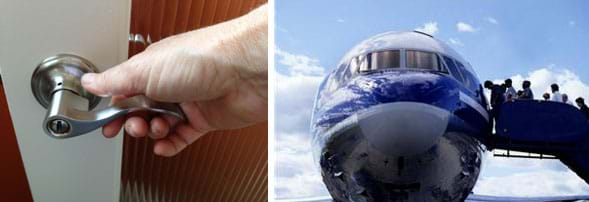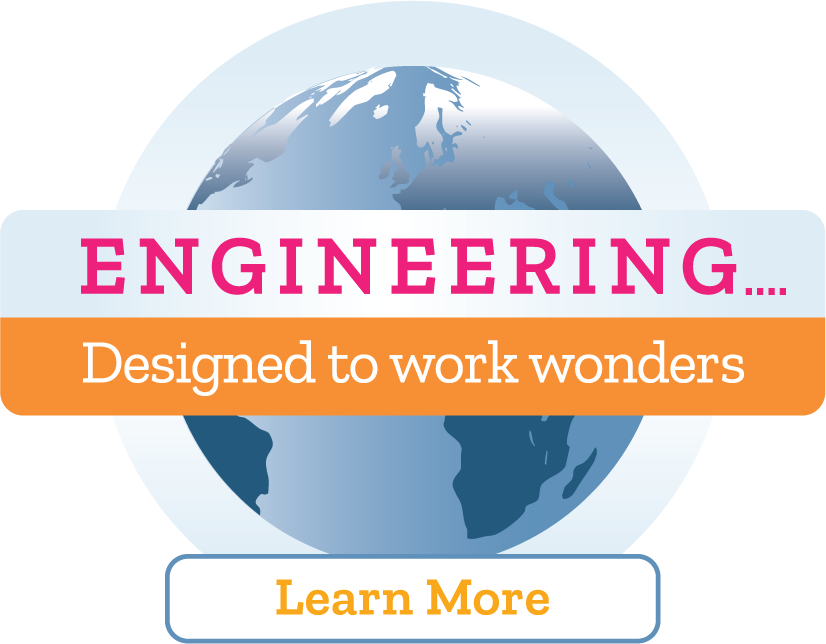Summary
Students are introduced to Newton's third law of motion: For every action, there is an equal and opposite reaction. They practice identifying action-reaction force pairs for a variety of real-world examples, and draw and explain simplified free-body diagram vectors (arrows) of force, velocity and acceleration for them. They also learn that engineers apply Newton's third law and an understanding of reaction forces when designing a wide range of creations, from rockets and aircraft to door knobs, rifles and medicine delivery systems. This lesson is the third in a series of three lessons intended to be taught prior to a culminating associated activity to complete the unit.
Engineering Connection
Consider the apple, which according to folklore, fell on Isaac Newton's head and sparked his thoughts on gravity and motion. Gravity applies a downward force on the apple's stem, and the stem applies an equal and opposite force upwards to keep the apple suspended. When the stem became too weak to apply an equally strong reaction force, the apple plunged downward toward his head.
Examples of Newton's third law of motion are ubiquitous in everyday life. For example, when you jump, your legs apply a force to the ground, and the ground applies and equal and opposite reaction force that propels you into the air. Engineers apply Newton's third law when designing rockets and other projectile devices. During launch, the burning fuel exerts a downward force, and the reaction force pushes the rocket into the air. In space, the rocket applies its rear thrusters to move forward, which provides another example of how engineers take advantage of reaction forces in their designs.
Learning Objectives
After this lesson, students should be able to:
- Identify action-reaction force pairs.
- Draw and explain simplified free-body diagrams showing action-reaction pairs.
- State and explain Newton's third law.
Educational Standards
Each TeachEngineering lesson or activity is correlated to one or more K-12 science,
technology, engineering or math (STEM) educational standards.
All 100,000+ K-12 STEM standards covered in TeachEngineering are collected, maintained and packaged by the Achievement Standards Network (ASN),
a project of D2L (www.achievementstandards.org).
In the ASN, standards are hierarchically structured: first by source; e.g., by state; within source by type; e.g., science or mathematics;
within type by subtype, then by grade, etc.
Each TeachEngineering lesson or activity is correlated to one or more K-12 science, technology, engineering or math (STEM) educational standards.
All 100,000+ K-12 STEM standards covered in TeachEngineering are collected, maintained and packaged by the Achievement Standards Network (ASN), a project of D2L (www.achievementstandards.org).
In the ASN, standards are hierarchically structured: first by source; e.g., by state; within source by type; e.g., science or mathematics; within type by subtype, then by grade, etc.
NGSS: Next Generation Science Standards - Science
| NGSS Performance Expectation | ||
|---|---|---|
|
MS-PS2-1. Apply Newton's Third Law to design a solution to a problem involving the motion of two colliding objects. (Grades 6 - 8) Do you agree with this alignment? |
||
| Click to view other curriculum aligned to this Performance Expectation | ||
| This lesson focuses on the following Three Dimensional Learning aspects of NGSS: | ||
| Science & Engineering Practices | Disciplinary Core Ideas | Crosscutting Concepts |
| Apply scientific ideas or principles to design an object, tool, process or system. Alignment agreement: | For any pair of interacting objects, the force exerted by the first object on the second object is equal in strength to the force that the second object exerts on the first, but in the opposite direction (Newton's third law). Alignment agreement: | Models can be used to represent systems and their interactions—such as inputs, processes and outputs—and energy and matter flows within systems. Alignment agreement: The uses of technologies and any limitations on their use are driven by individual or societal needs, desires, and values; by the findings of scientific research; and by differences in such factors as climate, natural resources, and economic conditions.Alignment agreement: |
| NGSS Performance Expectation | ||
|---|---|---|
|
MS-PS2-2. Plan an investigation to provide evidence that the change in an object's motion depends on the sum of the forces on the object and the mass of the object. (Grades 6 - 8) Do you agree with this alignment? |
||
| Click to view other curriculum aligned to this Performance Expectation | ||
| This lesson focuses on the following Three Dimensional Learning aspects of NGSS: | ||
| Science & Engineering Practices | Disciplinary Core Ideas | Crosscutting Concepts |
| Plan an investigation individually and collaboratively, and in the design: identify independent and dependent variables and controls, what tools are needed to do the gathering, how measurements will be recorded, and how many data are needed to support a claim. Alignment agreement: Science knowledge is based upon logical and conceptual connections between evidence and explanations.Alignment agreement: | The motion of an object is determined by the sum of the forces acting on it; if the total force on the object is not zero, its motion will change. The greater the mass of the object, the greater the force needed to achieve the same change in motion. For any given object, a larger force causes a larger change in motion. Alignment agreement: All positions of objects and the directions of forces and motions must be described in an arbitrarily chosen reference frame and arbitrarily chosen units of size. In order to share information with other people, these choices must also be shared.Alignment agreement: | Explanations of stability and change in natural or designed systems can be constructed by examining the changes over time and forces at different scales. Alignment agreement: |
International Technology and Engineering Educators Association - Technology
-
Compare, contrast, and classify collected information in order to identify patterns.
(Grades
3 -
5)
More Details
Do you agree with this alignment?
State Standards
California - Science
-
Apply scientific ideas to design, test, and refine a device that converts energy from one form to another.
(Grade
4)
More Details
Do you agree with this alignment?
-
Construct, use, and present arguments to support the claim that when the kinetic energy of an object changes, energy is transferred to or from the object.
(Grades
6 -
8)
More Details
Do you agree with this alignment?
-
Apply Newton's Third Law to design a solution to a problem involving the motion of two colliding objects.
(Grades
6 -
8)
More Details
Do you agree with this alignment?
-
Plan an investigation to provide evidence that the change in an object's motion depends on the sum of the forces on the object and the mass of the object.
(Grades
6 -
8)
More Details
Do you agree with this alignment?
Worksheets and Attachments
Visit [www.teachengineering.org/lessons/view/ucd_newton_lesson03] to print or download.Pre-Req Knowledge
Students should be familiar with the concepts of mass, properties of matter (weight, density, volume), and basic algebraic equations.
Introduction/Motivation
Newton's third law of motion builds further on the first and second laws of motion. The third law of motion states that for every action, there is an equal and opposite reaction. This can be observed both in objects at rest and those that are accelerating. For example, a resting box pushes down on the ground due to a gravitational force. In reaction to this, the ground presses back up, what we call a "normal force," at an equal magnitude. These forces balance so no acceleration of the box occurs. 
Newton's third law can also be observed in rockets and other projectiles. To launch, a large force is exerted from the engines of a rocket on the space behind it. In reaction to this force, the air pushes back with an equal magnitude, propelling the rocket forward. What other examples can you think of?
(Continue by showing the presentation and delivering the content in the Lesson Background section.)
Lesson Background and Concepts for Teachers
Teacher Preparation
- Be ready to show students the Forces and Newton's Third Law Presentation (a seven-slide PowerPoint® presentation) to teach the lesson.
- For the Hero's Engine demonstration, have handy a soda can, nail, piece of string and water. Use a nail to poke four holes around the base of an empty soda can. When the nail is in each hole, push the nail to the left or the right to angle the hole so the water will stream out on a tangent to produce thrust; do the same for each hole. Tie a string to the tab. For the demonstration, fill the can with water and lift it with the string over a sink or tub (or outside) so students can observe the rotational movement of the can spinning as water flows out of the holes. Refer to slide 2 and NASA Pop Can "Hero Engine" for instructions.
- In advance, make copies of Newton's Final Quiz (one per student).
- At some point during the presentation, perhaps when talking about some action-reaction examples (slides 3-6), go over how to draw the (conceptual) free-body diagram vectors (arrows) of force, velocity and acceleration, which students will be asked to do as part of the homework assignment.
Newton's Third Law of Motion Presentation Outline (slides 1-7)
Open the Forces and Newton's Third Law Presentation for all students to view and present the lesson content, guided by the script below and text in the slide notes. The slides are animated so clicking brings up the next text/image/answer.
Objective: To be able to identify action-reaction force pairs.
(slide 2) Introduce Newton's third law of motion: for every action, there is an equal and opposite reaction. Ask students: Have you heard this before? What do you think it means?
Then demonstrate the third law by showing students a modern version of Hero's Engine, which takes just a few minutes. Hero of Alexandria was an ancient Greek mathematician and experimentalist who lived in Egypt. His original engine was steam-powered, but the soda can version works well to demonstrate the same concept. For the demo, fill the prepared can with water and lift it with the string over a sink or tub (or outside) so students can observe the rotational movement as water flows out of the holes and the can spins. The can spins due to the reaction force associated with the flow of water.
Alternatively, demonstrate the third law by having one student sit on a scooter with a basketball and then throw the ball to another student. The reaction force from the throw is evident when the throwing student is propelled backward on the scooter.
(slide 3) Tell students that forces come in what are called "action-reaction force pairs." This slide shows a stack of concrete blocks resting on the ground. Identify the action-reaction pair for the class: the block's weight pushes on the ground and the ground pushes back up on the block.
(slide 4) Next, ask students to identify the action-reaction pair in the photograph of a firing cannon. The cannon exerts a force on the cannon ball, and the cannon ball exerts an equal and opposite force on the cannon. Point out that Newton's third law explains the recoil of projectile weapons such as cannons and guns. Students who have seen Wall-E may recall a scene in which the robot uses the fire extinguisher as a propulsion system (the reaction force causes the robot to move). Another good third law/recoil example is a garden hose dancing around the yard, moving because of the force of water running through it.
(slide 5) Ask students to identify the action-reaction force pairs in the photograph of a space shuttle launch. The space shuttle exerts a downward force, and the reaction force pushes it upwards.
(slide 6) Challenge students to identify all the action-reaction force pairs in this photograph of two football players. Examples: hand-helmet, hand-shoulder, ball-hand, shoe-ground.
This may be a good time to review how to draw (conceptual) free-body diagram vectors (arrows) of force, velocity and acceleration.
(slide 7) Review the concepts from all three lessons in this unit. Conclude the presentation with a review of the key concepts, as listed on the slide, with blanks for students to supply the answers. Through these three lessons, expect students to have developed an understanding of Isaac Newton's three laws of motion. These fundamental laws of physics describe how forces impact the motion of objects. Without forces, no changes in motion can occur. Understanding forces can be a very powerful thing! Because engineers understand how forces cause objects to slow down, speed up and turn, they are able to design complicated mechanical systems ranging from airplanes to door knobs to delicate drug delivery systems.
Next, conduct the associated activity, Sliding Textbooks, followed by the final quiz, as described in the Assessment section.
Associated Activities
- Sliding Textbooks - In a two-part experiment using a table, textbook, string and water bottle, student teams investigate how forces, such as applied force and friction, affect the acceleration of an object. They graph and analyze their results, consider applications for high- and low-friction surfaces, and see how forces play a role in engineering design.
Vocabulary/Definitions
acceleration: The amount of change in an object's velocity.
force: A push, pull or twist of an object.
inertia: An object's resistance to changing its motion.
Newton's first law: Unless an unbalanced force acts on an object, an object at rest stays at rest and an object in motion stays in motion.
Newton's second law: Force = mass x acceleration aka F=ma
Newton's third law: For every action, there is an equal and opposite reaction.
velocity: The speed and direction of an object.
Assessment
Pre-Lesson Assessment
Homework Review: Review students' answers to Newton's First and Second Laws Homework, which was assigned at the close of the previous lesson, What is Newton's Second Law? Verify that students are confident with Newton's first and second laws before continuing with Newton's third law.
Post-Introduction Assessment
Questions: As an embedded assessment, gauge student understanding of Newton's third law based on their responses to the questions on slides 4, 5 and 6 of the Forces and Newton's Third Law Presentation. Use the questions on slide 7 as a review prior to administering the final quiz.
Lesson Summary Assessment
Unit Quiz: After reviewing the questions on slide 7, answering any remaining student questions and conducting the associated activity, Sliding Textbooks, administer Newton's Laws Final Quiz as an assessment that covers the material in all three lessons in the unit. This requires students to draw (conceptual) free-body diagram vectors (arrows) of force, velocity and acceleration. Alternatively, administer the quiz after this lesson (before conducting the associated activity).
Subscribe
Get the inside scoop on all things TeachEngineering such as new site features, curriculum updates, video releases, and more by signing up for our newsletter!More Curriculum Like This

Students explore motion, rockets and rocket motion while assisting Spacewoman Tess, Spaceman Rohan and Maya in their explorations. First they learn some basic facts about vehicles, rockets and why we use them. Then, they discover that the motion of all objects—including the flight of a rocket and mo...

Students are introduced to the concepts of force, inertia and Newton's first law of motion: objects at rest stay at rest and objects in motion stay in motion unless acted upon by an unbalanced force. Students learn the difference between speed, velocity and acceleration, and come to see that the cha...

The purpose of this lesson is to teach students how a spacecraft gets from the surface of the Earth to Mars. Students first investigate rockets and how they are able to get us into space. Finally, the nature of an orbit is discussed as well as how orbits enable us to get from planet to planet — spec...

Through the continuing storyline of the Rockets unit, this lesson looks more closely at Spaceman Rohan, Spacewoman Tess, their daughter Maya, and their challenges with getting to space, setting up satellites, and exploring uncharted waters via a canoe. Students are introduced to the ideas of thrust,...
References
Louviere, Georgia. "Newton's Laws of Motion." 2006. Rice University. Accessed April 1, 2014. http://teachertech.rice.edu/Participants/louviere/Newton/index.html
"Newton's Laws." 2014. Physics Tutorial, The Physics Classroom. Accessed April 1, 2014. http://www.physicsclassroom.com/class/newtlaws
Copyright
© 2014 by Regents of the University of Colorado; original © 2013 University of California DavisContributors
Elizabeth Anthony; Scott Strobel; Jacob TeterSupporting Program
RESOURCE GK-12 Program, College of Engineering, University of California DavisAcknowledgements
The contents of this digital library curriculum were developed by the Renewable Energy Systems Opportunity for Unified Research Collaboration and Education (RESOURCE) project in the College of Engineering under National Science Foundation GK-12 grant no. DGE 0948021. However, these contents do not necessarily represent the policies of the National Science Foundation, and you should not assume endorsement by the federal government.
Last modified: January 24, 2024










User Comments & Tips